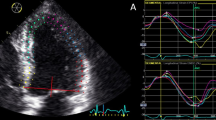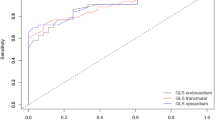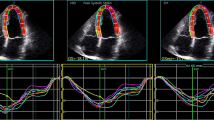Abstract
Speckle tracking global longitudinal strain (GLS) from dobutamine stress echocardiography (SE) predicts coronary artery disease (CAD). The diagnostic value of GLS from vasodilator SE and the additional value of layer-specific speckle tracking analysis are unclear. We explored the usefulness of layer-specific GLS and non-layer-specific strain (automated functional imaging, AFI) from adenosine SE. The included 132 patients (67% male, 62.6 (9.0) years), of which 46 (35%) had CAD defined as ≥1 stenosis ≥70% (≥50% in the left main), underwent adenosine SE and invasive coronary angiography. Resting AFI and layer-specific GLS were similar in patients with or without CAD (p > 0.05). The stress-rest difference (Δvalue = stress-value − rest-value) in patients with CAD was less pronounced compared to patients without proved CAD (Δendocardial GLS: −1.2 (3.5)% vs. −5.0 (3.2)%; Δmidventricular GLS: −0.95 (3.0)% vs. −4.2 (2.7)%; Δepicardial GLS: −0.7 (2.5)% vs. −3.4 (2.3)%; ΔAFI: −0.8 (2.9)% vs. −3.6 (3.1)%, p < 0.00001 for all comparisons). The diagnostic value of the three layer-specific GLS values and AFI were statistically similar (p = 0.19). The four Δvalues provided independent predictive value to the risk assessment given by gender, age, wall motion and ΔEF (p = 0.002, AFI and p < 0.0001, layer-specific GLS). The accuracies were acceptable (71–80%) with modest sensitivities (54–65%) and high specificities (80–91%). The deformation response to vasodilator infusion was associated with the presence of CAD. Endocardial, midventricular and epicardial GLS and AFI from adenosine SE had similar diagnostic values. The specificities were high, but the modest sensitivities are a limitation to the clinical application.


Similar content being viewed by others
References
Task Force Members, Montalescot G, Sechtem U et al (2013) 2013 ESC guidelines on the management of stable coronary artery disease: the Task Force on the management of stable coronary artery disease of the European Society of Cardiology. Eur Heart J 34:2949–3003
Edlund A, Albertsson P, Caidahl K, Emanuelsson H, Wallentin I (1991) Adenosine infusion to patients with ischaemic heart disease may provoke left ventricular dysfunction detected by echocardiography. Clin Physiol 11:477–488
Lang RM, Bierig M, Devereux RB et al (2005) Recommendations for chamber quantification: a report from the American Society of Echocardiography’s Guidelines and Standards Committee and the Chamber Quantification Writing Group, developed in conjunction with the European Association of Echocardiography, a branch of the European Society of Cardiology. J Am Soc Echocardiogr 18:1440–1463
Marcovitz PA, Armstrong WF (1992) Accuracy of dobutamine stress echocardiography in detecting coronary artery disease. Am J Cardiol 69:1269–1273
Reisner SA, Lysyansky P, Agmon Y, Mutlak D, Lessick J, Friedman Z (2004) Global longitudinal strain: a novel index of left ventricular systolic function. J Am Soc Echocardiogr 17:630–633
Choi JO, Cho SW, Song YB et al (2009) Longitudinal 2D strain at rest predicts the presence of left main and three vessel coronary artery disease in patients without regional wall motion abnormality. Eur J Echocardiogr 10:695–701
Shimoni S, Gendelman G, Ayzenberg O et al (2011) Differential effects of coronary artery stenosis on myocardial function: the value of myocardial strain analysis for the detection of coronary artery disease. J Am Soc Echocardiogr 24:748–757
Biering-Sorensen T, Hoffmann S, Mogelvang R et al (2014) Myocardial strain analysis by 2-dimensional speckle tracking echocardiography improves diagnostics of coronary artery stenosis in stable angina pectoris. Circ Cardiovasc Imaging 7:58–65
Ingul CB, Stoylen A, Slordahl SA, Wiseth R, Burgess M, Marwick TH (2007) Automated analysis of myocardial deformation at dobutamine stress echocardiography: an angiographic validation. J Am Coll Cardiol 49:1651–1659
Hanekom L, Cho GY, Leano R, Jeffriess L, Marwick TH (2007) Comparison of two-dimensional speckle and tissue Doppler strain measurement during dobutamine stress echocardiography: an angiographic correlation. Eur Heart J 28:1765–1772
Aggeli C, Lagoudakou S, Felekos I et al (2015) Two-dimensional speckle tracking for the assessment of coronary artery disease during dobutamine stress echo: clinical tool or merely research method. Cardiovasc Ultrasound. doi:10.1186/s12947-015-0038-z.
Adamu U, Schmitz F, Becker M, Kelm M, Hoffmann R (2010) Advanced speckle tracking echocardiography allowing a three-myocardial layer-specific analysis of deformation parameters. Eur J Echocardiogr 10:303–308
Leitman M, Lysiansky M, Lysyansky P et al (2010) Circumferential and longitudinal strain in 3 myocardial layers in normal subjects and in patients with regional left ventricular dysfunction. J Am Soc Echocardiogr 23:64–70
Belghitia H, Brette S, Lafitte S et al (2008) Automated function imaging: a new operator-independent strain method for assessing left ventricular function. Arch Cardiovasc Dis 101:163–169.
Norum IB, Ruddox V, Edvardsen T, Otterstad JE (2015) Diagnostic accuracy of left ventricular longitudinal function by speckle tracking echocardiography to predict significant coronary artery stenosis. A systematic review. BMC Med Imaging. doi:10.1186/s12880-015-0067-y
Reimer KA, Jennings RB (1979) The “wavefront phenomenon” of myocardial ischemic cell death. II. Transmural progression of necrosis within the framework of ischemic bed size (myocardium at risk) and collateral flow. Lab Invest 40:633–644
Austen WG, Edwards JE, Frye RL et al (1975) A reporting system on patients evaluated for coronary artery disease. Report of the Ad Hoc Committee for Grading of Coronary Artery Disease, Council on Cardiovascular Surgery, American Heart Association. Circulation 51:5–40
Kannel WB, McGee D, Gordon T (1976) A general cardiovascular risk profile: the Framingham Study. Am J Cardiol 38:46–51
Diamond GA, Forrester JS (1979) Analysis of probability as an aid in the clinical diagnosis of coronary-artery disease. N Engl J Med 300:1350–1358
Picano E, Lattanzi F, Orlandini A, Marini C, L’Abbate A (1991) Stress echocardiography and the human factor: the importance of being expert. J Am Coll Cardiol 17:666–669
Hoffmann R, Marwick TH, Poldermans D et al (2002) Refinements in stress echocardiographic techniques improve inter-institutional agreement in interpretation of dobutamine stress echocardiograms. Eur Heart J 23:821–829
Anthopoulos LP, Bonou MS, Sioras EP, Kranidis AI, Kardaras FG, Antonellis IP (1997) Echocardiographic detection of the extent of coronary artery disease in the elderly using dobutamine and adenosine infusion. Coron Artery Dis 8:633–643
Marwick T, Willemart B, D’Hondt AM et al (1993) Selection of the optimal nonexercise stress for the evaluation of ischemic regional myocardial dysfunction and malperfusion. Comparison of dobutamine and adenosine using echocardiography and 99mTc-MIBI single photon emission computed tomography. Circulation 87:345–354
Amundsen BH, Helle-Valle T, Edvardsen T et al (2006) Noninvasive myocardial strain measurement by speckle tracking echocardiography: validation against sonomicrometry and tagged magnetic resonance imaging. J Am Coll Cardiol 47:789–793
Sun YG, Zhao QH, He RM, Shen WF (2008) Quantitative evaluation of ischemic myocardium by adenosine tissue Doppler stress echocardiography. Zhonghua Xin Xue Guan Bing Za Zhi 36:907–911.
Cusma-Piccione M, Zito C, Oreto L et al (2015) Longitudinal strain by automated function imaging detects single-vessel coronary artery disease in patients undergoing dipyridamole stress echocardiography. J Am Soc Echocardiogr 28:1214–1221
Sakurai D, Asanuma T, Masuda K, Hioki A, Nakatani S (2014) Myocardial layer-specific analysis of ischemic memory using speckle tracking echocardiography. Int J Cardiovasc Imaging 30:739–748
Sarvari SI, Haugaa KH, Zahid W et al (2013) Layer-specific quantification of myocardial deformation by strain echocardiography may reveal significant CAD in patients with non-ST-segment elevation acute coronary syndrome. JACC Cardiovasc Imaging 6:535–544
Ng AC, Sitges M, Pham PN et al (2009) Incremental value of 2-dimensional speckle tracking strain imaging to wall motion analysis for detection of coronary artery disease in patients undergoing dobutamine stress echocardiography. Am Heart J 158:836–844
Wierzbowska-Drabik K, Hamala P, Roszczyk N et al (2014) Feasibility and correlation of standard 2D speckle tracking echocardiography and automated function imaging derived parameters of left ventricular function during dobutamine stress test. Int J Cardiovasc Imaging 30:729–737
Tonino PA, De Bruyne B, Pijls NH et al (2009) Fractional flow reserve versus angiography for guiding percutaneous coronary intervention. N Engl J Med 360:213–224
Acknowledgements
The staff at the Cardiovascular Research Unit is acknowledged for their immense work with patient screening, inclusion, interviews and data registration. We are grateful to the Health Research Fund of Central Denmark Region, J & O Madsen’s Fund and EG A/S for financial support enabling the accomplishment of the study.
Author information
Authors and Affiliations
Corresponding author
Ethics declarations
Conflict of interest
None of the authors have any financial or other potential conflicts of interests to disclose.
Rights and permissions
About this article
Cite this article
Ejlersen, J.A., Poulsen, S.H., Mortensen, J. et al. Diagnostic value of layer-specific global longitudinal strain during adenosine stress in patients suspected of coronary artery disease. Int J Cardiovasc Imaging 33, 473–480 (2017). https://doi.org/10.1007/s10554-016-1022-x
Received:
Accepted:
Published:
Issue Date:
DOI: https://doi.org/10.1007/s10554-016-1022-x




